Chapter 17
Pigs and Poultry on the Fertility Farm
In the building up of fertility, especially on the poor light-land farm, there is no animal more effective than the pig. Though I would not suggest that the pig is an essential part of fertility building, there is no quicker or more economical contributor to soil fertility. There is, consequently, a strong case for keeping pigs on the farm of low fertility for no other reason than that of fertility making, quite apart from any direct profits which may accrue. I kept pigs in the early days at Goosegreen and have used them in large numbers for land reclamation work which I have directed elsewhere. The system used, which has already been copied with success in a number of land reclamation schemes, was originated by my mother and brothers (M. E. Turner & Sons, Brockholes Farm, Branton, Doncaster), with their large pedigree Essex herd, before the war.
In the nineteen-thirties they took over one of the poorest blow-away sand-land farms in South Yorkshire, which was already known as incapable of growing anything without large quantities of artificial fertilizer, and because of the difficult times through which farming was passing, few farmers had the means to risk the immense cost of artificial fertilizers with no certain prospect of the resultant produce finding a profitable market. The owners of the farm were therefore unable to find a tenant for the farm, at any rent, which gives a fair guide as to the condition of the soil. My mother and brothers bravely stepped in and took on the farm, and transformed it. Losses followed for a few years while the harmful effect of heavy doses of chemicals was being experienced, but the land has now been built up to a state of fertility unequalled in the district. After the 1950 harvest (which was the worst in living memory) I had a letter from one of my brothers saying, 'We have just harvested the heaviest crops ever remembered in this district, over the whole 300 acres of the farm, without an ounce of tillage' (the North Country word for artificial fertilizers). And such results were achieved by the use of pigs, supported by the organic methods described in the rest of this book.
Tackling a field of the farm at a time, for large areas had gone back to rough grassland infested with weeds, pigs were used for every operation of reclamation, except the actual sowing of seed and levelling the ground with disc harrows.
Starting with a field in its rough state, large numbers of pigs of all ages were turned into the field and folded over it. Where there was good hedge shelter no other shelter was provided, but where the hedges were bare, rough timber and galvanized sheeting shelters were provided for sows with young litters. The Essex pigs which my brothers use seem, however, to prefer the hedge bottom to the sheds, even for farrowing.
The pigs are allowed a minimum of food, for this reason: if a large number of store pigs is available they are preferred to sows or gilts close to or just after farrowing. They then find most of their keep from the grass, weeds and roots of all kinds which they dig out as the whole field is thoroughly and completely turned over. Coarse roots of weeds, which are extremely difficult to eradicate on this rough land by any other means, are dug up by the pigs to provide food and at the same time they clean the land more effectively than is possible with a machine. Labour for attending to the pigs is reduced to the very minimum because, at the most, the pigs receive only one small feed daily, and this is raw potatoes or grain.
If the number of available pigs is limited, then folding may be resorted to, in order to ensure thorough turning of every square foot. My brothers have turned pigs on to fields as thickly as 100 to the acre in carrying out this reclamation work, but if the herd of pigs is not big enough to allow so many, the concentration may be varied by means of a fold or electric fence. If pigs of various sizes are used, two strands of electrified wire are needed, as the bigger pigs soon learn to go over the electrified single strand and the smaller pigs may go under. I have even seen a sow lying, feeding her litter, on an electrified fence which had been erected too near the ground.
When the field is completely turned over and well cultivated by the pigs, they move on to start 'ploughing' another field, and the first field is levelled and a rough seed-bed prepared with the disc harrows. Thousand-headed kale is then broadcast over the field.
When the kale has grown it provides all the food for another batch of pigs, which are again turned loose on the field or folded over sections of it. Again, if the herd is big enough to avoid the work of moving folds in order to concentrate a large number on a small area, the amount of labour needed to look after the pigs is no more than a walk around to inspect the pigs once daily. The kale is grazed by the pigs at a young leafy stage and they clear the whole crop down to the ground, leaving at the most only small stumps.
Then the disc harrows go in again, and once or twice over the field with disc harrows prepares a seed-bed ready for sowing wheat. Thick concentrations of pigs twice over the field and the consuming on the field of weeds, weed roots, and then the kale, have left a good covering of dung, lightly trodden in by the pigs and then incorporated into the topsoil by the disc harrows. On the poorest land, following this double dressing of pig manure, part of which has advanced in its decomposition, good crops of wheat have always been harvested. Even better results are obtained when fattening or breeding pigs are used to graze the kale, and are given additional feeding in the form of pig meal or cubes.
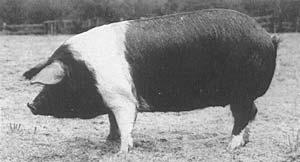
15a. M.E. Turner & Son's Keresforth Grand Duchess, a typical Essex gilt reared by methods described at the beginning of in this chapter
|
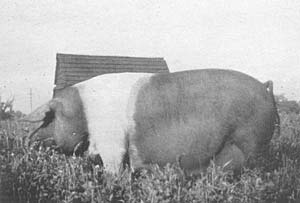
15b. M.E. Turner & Son's Pedigree Essex Sow Keresforth Duchess (twice a Supreme Champion, all breeds) carrying a litter of 12, all subsequently reared.
|

15c. The 'fertility' plough. Reclaiming derelict land with pigs
|
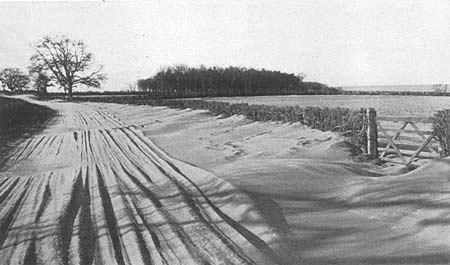
16a. Soil erosion in Britain 1949. Soil blowing away in the formerly rich Fens of Lincolnshire. 'Extractive' farming, the removal of trees and hedges and repeated chemical manuring have resulted in serious soil erosion and crop pests such as eel-worm. Fertility farming can prevent such scenes as this from spreading over Britain
|
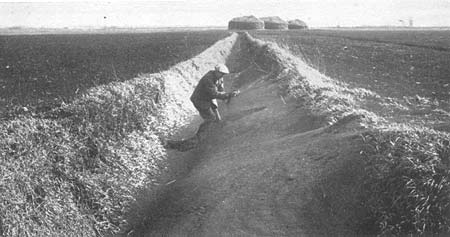
16b. Soil and young plants blown into dykes in the Fenlands. The first British desert may thus be caused unless it is arrested by Fertility farming
|
I have criticized the plough in various ways, mainly for its wastefulness of time, power and labour. But this demonstration by my brothers of 'ploughs' which need neither petrol, nor oats, nor hardly any human time or labour in order to turn the turf, and which in the process of this powerless ploughing, spread fertility over the soil -- and produce pork and bacon as a by-product -- leaves at least one type of plough for which I have nothing but admiration.
There could be no better example of the system of farming which I have tried to advocate in this book, that is, one which takes every opportunity to observe the ways of nature, takes the fullest advantage of every free provision of nature, and simplifies every farming operation until the farm almost operates itself, with a minimum of labour.
The above system is designed primarily to take advantage of the pig as a natural land reclaimer and fertility maker, but pigs, as a business in themselves and as an income-making branch of the farm in their own right, involve rather more intensive methods, and in this case the following is my method, which differs only in a few important respects from those in general use.
Up to the time of farrowing, gilts and sows should be allowed as much fresh air and exercise as possible, and not be allowed to accumulate any excess of flesh, so that they run on in an active and healthy condition: 3 to 4 lb. of meal a day in winter, and 2 to 3 lb. a day in summer, will maintain the in-pig sows in a fit condition up to three weeks before farrowing.
Three weeks or a fortnight before farrowing, the sow is put into the pen, where she will remain until the farrows are weaned. The pen is well bedded with straw -- chaffed straw being preferable, as the little pigs may entangle or smother themselves in long straw. The sow is given 4 or 5 lb. per day of the following ration: fish meal, meat meal or dried milk powder, 1 part; bean meal, 1 part; wheat meal, 2 parts; barley meal, 1 part; maize meal, 1 part (or barley meal, 2 parts).
As farrowing time approaches, the sow is closely watched but not interfered with, unless she is obviously in difficulties. No special feeding or treatment is necessary unless the sow is ill or weak with prolonged parturition. The sow's rations should now be increased after farrowing to 9 to 12 lb., according to the size of her litter.
The young pigs will begin to eat at three weeks of age, and they are fed separately with a mixture of dried milk powder or fish meal, 1 part; bean meal, 1 part; wheatings, 4 parts; barley meal, 2 parts; maize meal, 1 part; bran, 1 part; mixed if possible with skimmed milk.
A portion of the pen is railed off with a separate trough and made available for the young pigs but not for the sow. An ample supply of fresh green food is given daily and always, when it is available, use separated milk for mixing the meal instead of water. This is given in the proportion of 1 gallon of separated milk to each 6 lb. of meal. The main object in feeding young pigs should be to maintain, right through, the rapid liveweight gain that is made by the young pigs while sucking the sow. To do this the pigs should be given separated milk as soon as they start eating, and particularly at the time they are weaned. There is always a risk of young pigs receiving a set-back at weaning when they are taken suddenly from the sow and their rations of milk cease. As they get accustomed to being with the sow after weaning, and it is seen that they are forging ahead, then the milk may gradually be reduced.
The longer the young pigs are with the sow, and the stronger they are at weaning, the more rapid is their liveweight increase, from weaning to killing weight. Commercial pig-keeping, however, demands a limit to the length of time the young pig may stay with the sow if two litters are to be reared from each sow within the twelve months. The ideal age, then, for weaning is eight weeks.
The sow is mated again at the first heat period after weaning -- usually the fourth or fifth day after the young pigs are removed. A sow put to the boar at the first heat period will always produce a bigger litter than if left until a later period. A rapid improvement in the sow's condition will take place when the young pigs leave her, and by mating at the first heat period, owing to the greater activity of the reproductive organs at this time, larger litters are obtained.
The young pigs are kept on the same ration until they are thirteen weeks old, when the mixture is gradually changed to a ration containing less protein and a higher percentage of carbohydrates. The following is an ideal mixture for the pigs from thirteen weeks onwards: dried blood or milk powder, 1/2 part; palm-kernel meal, 1 part; wheat meal, 2 parts; barley meal, 5 parts; maize meal or barley meal, an additional 1-1/2 parts.
The fish meal is dropped in the later stages of fattening, or may be replaced all through by blood meal, dried milk powder, or some other form of high protein concentrate. This is to avoid the risk of tainting the flesh, as so often happens with a mixture containing fish meal. There are several excellent high-protein foods on the market which could quite well take the place of fish meal, and the price compares favourably with that of fish meal. Milk powder, used right through from birth, eliminates the change over from fish meal between rearing ration and fattening ration.
Given average conditions, the pig fed on these lines makes bacon 210 to 220 lb. live weight in twenty-five to twenty-six weeks.
A rough guide for the quantity of food required by growing pigs is to feed approximately 1/4 lb. meal for every week of age up to twenty-four weeks.
The following table will summarize the meal requirements of various classes of pigs at different ages:
| 4 weeks old: |
1/2-3/4 lb. per day, according to size of litter |
| 8 weeks old: |
1-1/2-2 lb. per day |
| 10 weeks old: |
2-1/2 lb. per day |
| 12 weeks old: |
3 lb. per day, gradually changing to fattening mixture |
| 14 weeks old: |
3-1/2 lb. per day |
| 16 weeks old: |
4 lb. per day |
| 20 weeks old: |
5 lb. per day |
| 24 weeks old: |
6 lb. per day, which allowance should not be exceeded |
| Sow in pig: |
3-4 lb. per day |
| Sow in milk: |
9-12 lb. per day, according to size of litter |
| Working boars: |
5-6 lb. per day |
It is essential that all pigs have a regular daily supply of greenstuff, if they are not running out, even if it is only a grass sod thrown into the pen. Where pigs have no access to the pasture, and a good supply of cabbage or other green food is not available, the simple practice of digging a grass sod every day for each pen of pigs will work wonders.
To ensure the rapid and healthy growth of young pigs it is essential that they be kept free from worms. The regular use of garlic helps in this respect -- one tablet for each pig daily, or as much chopped garlic as they will eat, up to one plant each daily. As a safeguard, they may be dosed for worms at the age of four weeks and again at weaning, though this is not necessary with pigs on free range. Garlic or male fern may be used for this. Details of dosage will be given by herbal firms supplying the garlic or male fern.
Poultry
I shall not go into detail about poultry except to cover two points which have a direct bearing on fertility farming and which make it advisable, if the fullest benefit is to be derived from these methods, that poultry should be kept.
Firstly, and this is the most encouraging point in these days of costly feeding stuffs, is that I have discovered that poultry require less food as the fertility of the farm increases, for they find much of their own food in the humus and weeds of the fertility farm.
Secondly, in order to take advantage of this free food, we have found the best system to be a combination of folding and free range.
To elaborate these two points:
Though hens will generally mop up all the food which one is able to allow them, even when on free range, I found that on certain fields, where humus was abundant, and especially in the oat or wheat stubbles following the composted roots, or following beans which had been composted, the birds surprised me by showing only slight interest in the food which I carried to them. They would usually come to meet me when I arrived with the food which in the semi-confinement of folds they would consume to the last morsel, but after pecking away at it for a while they would wander off to their obviously far more palatable and juicy soil organisms -- worms, insects, and much that was invisible to the human eye -- which they were getting from the humus-rich soil without overmuch scratching. If it weren't that I am sure there is much in compost and humus-rich soil which the hen eats, and which I am unable to identify with my own eyes, I would almost venture to suggest that compost is in itself a good food for poultry. For the hens most certainly consume large quantities of what looks like pure compost whenever they get the opportunity. Additionally, the young weeds which grow abundantly in humus-rich stubbles, especially chickweed, are eaten avidly by the poultry.
A number of poultry farmers troubled with feather pecking and cannibalism among their birds are finding that the actual feeding of compost to hens in folds, or any kind of confinement, puts a stop to the habit. It is well known that these troubles are due to a deficiency of some natural element in the diet, and it seems that compost provides it.
The whole system of fertility farming builds up an immense earthworm population which, if the poultry are moved around to the high fertility fields, goes a long way towards satisfying their protein requirements. In this way once more, as with the Brockholes pig-ploughing system, we operate a dual process of free food and fertility building simultaneously.
This is one more example of the double benefits to be gained from farming with, instead of against, nature.
I hesitate to quote this as a further argument in favour of compost, for I heartily deplore the aura of mystery and magic which some enthusiasts have thrown around the whole idea of using compost, much to the detriment of the thoroughly practical work of the late Sir Albert Howard. Though, of course, some degree of mystery about a natural process need not be a deterrent to the practical farmer with the initiative to experiment for himself. Much in this life must be taken on faith, and the wise man will not hesitate to put his faith in something which works with obviously cumulative benefit to everything on the farm.
For working a combination of folding and free range, the aluminium Igloos invented by a practical poultryman, Mr. Hubert Salsbury, of Evenley, near Brackley, Northants, are ideal. We use the Igloo and its detachable run together for rearing chicks right up to laying stage. If necessary, an oil heater may be placed under the slatted floor of the Igloo (each slat is separately removable), and for day-old chicks a light wire-netting floor may be put over the slats to prevent chicks falling through.
As the chicks grow they may go out into the run, and later the run may be detached from the Igloo night quarters and the birds allowed free range, or part-time range and part-time folding. When the birds approach maturity the slats may be removed completely, giving the birds direct contact with the soil, except for the perches, or a few of the slats may remain to give additional perching space, thus increasing the capacity of the night quarters and accommodating on free range far more birds than would be possible with continuous folding.
As a valuable natural tonic and disease preventive we always use some chopped garlic in the food or put garlic tablets in the drinking water. The value of garlic for poultry was demonstrated to me when one of my men brought some chickens into his cottage garden which abuts on to the farm. They proved to be dying of coccidiosis, and some of our growing pullets started with the same trouble. We immediately put garlic in the drinking water and the disease disappeared in almost a matter of days. I have since regarded garlic as one of the surest safeguards against poultry diseases, for it is not always possible to give the hens entirely home-grown food. On my farm this goes first to the cattle, and if we have to buy food we buy for the hens. We also use as a seaweed mineral supplement, and especially for the iodine which seems to be beneficial to laying hens, as well as milk cows and other breeding animals, seaweed powder which is now available in quantity at a price cheaper than manufactured chemical mineral supplement. See Appendix for Herbal Suppliers.
Self-Service for Hens
There is yet another way in which, by adaptation, an already successful system of poultry keeping can be made even more labour saving, foolproof and profitable.
For those who find it hard to believe that the snags can so easily be removed from farming by taking advantage of nature's free provisions, all I can say is come and see for yourself. For on re-reading parts of this book I find myself almost doubting my own words. But I only have to walk out on to my own farm to see with my own eyes that what I have written is not the exaggerated product of my dreams, but the solid reality of abundance, which is the automatic response of nature observed and respected.
The modern poultry keeping system of hen yards, or the deep-litter system, provides a healthy and humane, yet equally profitable alternative to the abominable practice of laying batteries. It gives the same high production as the battery system, yet allows the hens ample exercise, the freedom to scratch, and the health essentials of natural food and contact with the earth.
But even this system has its snags, of which two are feather pecking and -- a factor common to all poultry keeping, particularly under conditions of semi-confinement -- the high cost of protein foods.
Add the compost heap to the hen yard, with its abundance of earthworms -- deliberately cultivated for the purpose if possible -- and both these snags are removed. For hens with plenty of scratching, which is productive of an unlimited supply of worms, will have neither the time nor the desire to peck one another. And a large proportion of their food of a kind far more valuable than any that can be bought or even grown on the farm is provided free of charge.
The hen-yard system may be operated from any old farm shed or buildings with an open yard attached or to which a yard may be added by straw bales or other hen-proof and weatherproof walls or fence. The yard should be open to the sky, but fenced with wire-netting high enough to prevent the hens from flying out.
The area should be approximately four square feet for each bird in the yard and two square feet in the shed. The floor of the yard should be soil -- or soil should be carted in. This is essential for the worms and soil organisms which will later be mixed into the litter by a combination of natural infiltration and the activity of the birds.
The laying boxes are placed in the darkest part of the house, raised from the floor, if possible, and fronted with a curtain of sacking -- with a small head-hole at the bottom fringe of the sacking just big enough to enable them to see their way in and out. This prevents the hens turning back to the nest to eat their eggs, and discourages any habitual egg-eaters which go around the nest-boxes looking for eggs to eat.
During the spring or early summer build a compost heap in the centre of the hen yard, in the way described in Chapter 10. 'Yard-and-Parlour' Milking and Compost, How to Make Compost without Turning -- but proportionately smaller to fit the size of the yard -- making certain to use ground limestone which will later be used by the hens. Earthworms should be added if they are available, in order to get the maximum earthworm population into the compost, and the soil beneath and around it, by the time the hens are brought into the yard for laying purposes in the autumn.
Sawdust spread to a depth of three or four inches over the rest of the yard will also encourage earthworms and break down partially, in readiness to provide an ideal scratching base to the straw litter which will be added when the hens come in.
By the early autumn the compost in the yard will be the ideal dining-table for the hens, teeming with free protein food and full of numerous soil organisms and other health and production essentials. This will provide a wonderful stimulus to egg production at a time when it is most needed. The earthworms will continue to breed under the litter, providing a continuous 'self-service canteen'.
Litter in the form of straw is added to this base periodically as the hens break it down by means of scratching and pecking. Daily, or as often as may seem advisable, the litter and compost is forked over and into rough heaps, exposing the bottom of the yard and bringing to the surface more food for the fowls. They will scratch it back as they find their food and break up the fresh litter and mix it with the partially decayed material.
Litter is also provided in the shed, where the birds operate in wet weather. Food and water is provided in the usual way, in the house, but far less than the usual protein ration is needed where earthworms are added and encouraged.
A corner of the yard is covered with galvanized sheeting to provide a dust bath.
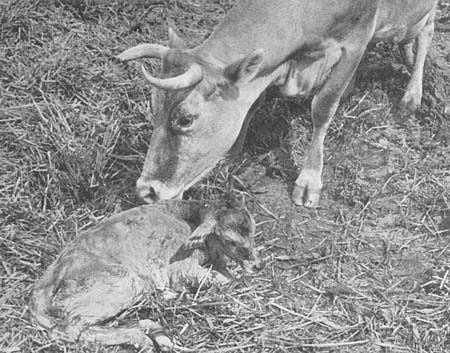
18a. Just dropped! The field is the best place for a cow to calve
|
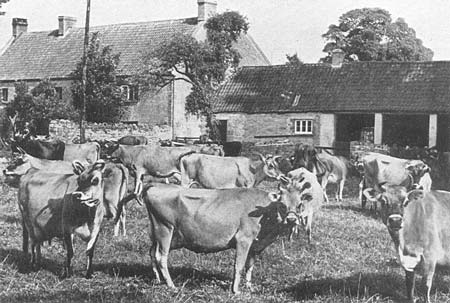
18b. Some of the author's herd including three 15-year-old cows. In the centre foreground, a prize-winning home-reared heifer yielding 54 lb. milk daily with her first calf, on home-grown food
|
Next: 18. Livestock Diseases
Back to Contents
Back to Small Farms Library index
Community development | Rural development
City farms | Organic gardening | Composting | Small farms | Biofuel | Solar box cookers
Trees, soil and water | Seeds of the world | Appropriate technology | Project vehicles
Home | What people are saying about us | About Handmade Projects
Projects | Internet | Schools projects | Sitemap | Site Search | Donations | Contact us

